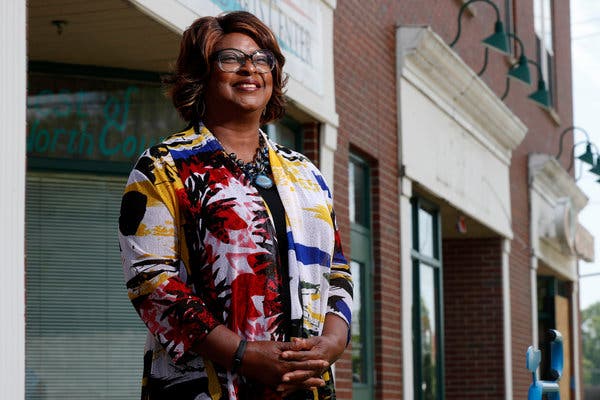Advertisement

Hi. Welcome to On Politics, your guide to the day in national politics. I’m Thomas Kaplan, filling in for Lisa Lerer.
Senator Elizabeth Warren of Massachusetts turned heads on Sunday with the crowd at her town hall in Seattle: some 15,000 people, according to an estimate provided by her campaign.
Joe Nguyen, a state senator who introduced Ms. Warren at the event, said that as far he could see, “it was just people.”
It was the biggest audience Ms. Warren has drawn yet as a presidential candidate, breaking a record she set just six days earlier, when an estimated 12,000 people came to her town hall in St. Paul.
“I just think it’s a sign that people are ready for change in Washington,” Ms. Warren told reporters.
Impressive crowds in big cities do not necessarily translate into success in early voting states like Iowa and New Hampshire, and the first nominating contest will not be held for five more months. But they can indicate how a candidate is catching on with voters.
Big crowds offered a sign of the interest in Howard Dean, the former governor of Vermont, during his 2004 presidential campaign — including an event in Seattle in August 2003 that drew somewhere in the ballpark of 8,000 to 10,000 people.
Senator Bernie Sanders of Vermont drew enormous crowds during his 2016 presidential bid, including a similar turnout to Ms. Warren’s when he visited Seattle in August 2015. He has also drawn big crowds in his 2020 bid, including 16,000 people in San Francisco, 15,000 in Los Angeles, 13,000 in Brooklyn and 12,500 in Chicago, according to his campaign. Those four events took place in March.
Senator Kamala Harris of California drew 22,000 people when she kicked off her presidential bid with a rally in Oakland, Calif., in January, according to her campaign. Speaking to reporters last week, former Vice President Joseph R. Biden Jr. played down the importance of crowd sizes. “This is a marathon,” he said.
President Trump loves to boast about his own impressive crowds, though he has shown a tendency to exaggerate their size. Large crowds — like a rally in Mobile, Ala., in August 2015 that drew at least about 20,000 people, with some estimates even higher — were a harbinger of Mr. Trump’s strength in the 2016 primary campaign.
The crowds are a point of pride for the Warren campaign — and a validation of her strategy to devote time to town halls and stick around afterward for her increasingly famous “selfie line.” Ms. Warren has now visited 27 states and Puerto Rico during her eight months as a presidential candidate, according to her campaign.
An essential factor, her team says, is her decision not to hold private fund-raisers with wealthy donors, which frees up her schedule.
Ms. Warren spoke to the crowd for an hour in Seattle, and then she spent about four hours taking pictures with people, according to her campaign, which said she has now taken pictures with more than 52,000 people since entering the race.

____________________
Drop us a line!
We want to hear from our readers. Have a question? We’ll try to answer it. Have a comment? We’re all ears. Email us at onpolitics@nytimes.com.
____________________
The New York Times analyzed all of the grades issued by the National Rifle Association to members of Congress since 2008 — a measure of the breadth and depth of the group’s support on Capitol Hill — and found that the group has significantly fewer allies in Congress than it did a decade ago, driven by the near-total severing of ties to Democrats.
The Democratic buffer was once crucial. When Democrats controlled both chambers of Congress in 2009-10, the N.R.A.’s alliances with Democrats helped forestall new gun restrictions. In the long term, the loss of the N.R.A.’s Democratic buffer poses a threat to the group’s power, no matter what happens in the current gun control debate.
But Republican support is still going strong. Over 90 percent of congressional Republicans have “A” grade ratings. The N.R.A. also continues to have clout with President Trump and Senate leaders, which could be enough to block the current push for background checks.
Party lines around the N.R.A. are hardening. The group was once largely insulated from shifts in partisan control: It could block gun restrictions no matter which party controlled Congress and the White House. But now, Republican majority in both houses of Congress would most likely hamper gun control measures, while a Democratic majority would make it easier to pass background checks and other legislation.
The N.R.A.’s electoral influence is faltering. There’s been very little backlash for N.R.A. defectors in the last decade. In fact, legislators who have moved away from the N.R.A. have then fared better electorally, further weakening the group’s argument that defying it would be political suicide.
____________________
• The sisters who tried to take down Jeffrey Epstein nearly a decade ago.
• As Elizabeth Warren calls for “big, structural change,” she’s reassuring Democratic leaders that she would rebuild the party — not seek to conquer it.
• Remember the story of the young Christian missionary who was killed after attempting to befriend the inhabitants of a remote Indian island? GQ has the fascinating full story.
____________________
The idea of dropping a nuclear bomb into a hurricane in order to destroy it has been around so long that the National Oceanic & Atmospheric Administration created a page explaining why it’s a terrible plan.
Spoiler: Nuking a hurricane would just create a bigger, radioactive hurricane.
_____________________
Were you forwarded this newsletter? Subscribe here to get it delivered to your inbox.
Thanks for reading. Politics is more than what goes on inside the White House. On Politics brings you the people, issues and ideas reshaping our world.
Is there anything you think we’re missing? Anything you want to see more of? We’d love to hear from you. Email us at onpolitics@nytimes.com.


